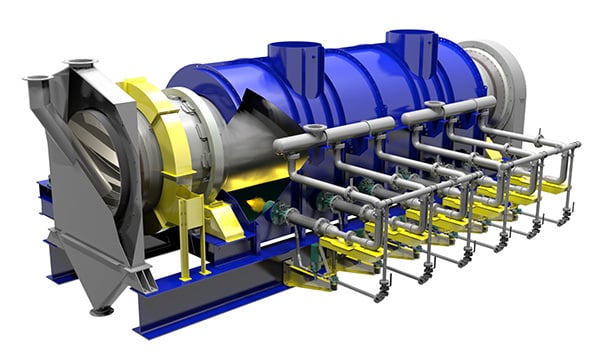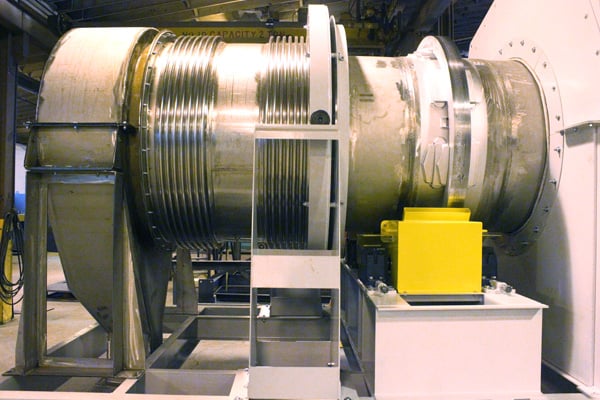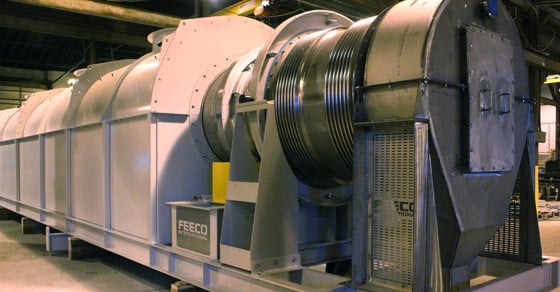As the world continues to move away from fossil fuels, pyrolysis is becoming an increasingly important tool, helping to create a more circular economy by opening up opportunities in the production of alternative fuels from a variety of wastes.
The rotary pyrolysis kiln is chosen for this application for several reasons, the most important of which, is its continuous processing capabilities.
About Pyrolysis
Pyrolysis is the thermal decomposition of an organic material under starved-air or oxygen-deficient conditions.
The benefits of pyrolysis are two-fold; the process produces renewable fuel sources by upgrading waste materials to value-added products, while also providing a much-needed outlet for a wide range of waste streams.
Depending on the setup, pyrolysis can produce three products: a liquid (condensed from gas), a non-condensable gas (syngas), and solids in the form of char and ash. Because pyrolysis occurs in an oxygen-starved environment and combustion does not occur, these products have a high heating value. The parameters of the pyrolysis process, in combination with the composition of the starting material, determine the amount of each product yielded, as well as their individual calorific values.
Liquid derived from the pyrolysis process can be further processed into various types of fuel, including diesel, jet engine fuel, and more, while syngas is amenable to power and heat generation. The remaining char or ash can be used in a variety of ways depending on its physical and chemical composition.
It’s important to note that pyrolysis is distinctly different from calcination; the terms are sometimes used interchangeably. While pyrolysis occurs in a starved-air environment, calcination is generally carried out in an excess-air environment, and instead of volatilizing organics, focuses on chemical separation.
Pyrolysis Kiln Applications
Pyrolysis can be useful in processing a range of materials, bringing new life to materials that were previously considered wastes. Typical applications include:
Biomass
Biomass, or lignocellulosic materials such as forest products and agricultural residues are plentiful waste streams that could provide significant value if pyrolyzed. The pyrolysis of biomass can produce several higher-value products, including biocoal (a synthetic form of coal that burns cleaner when used as an energy source), biochar, and activated carbon.
The conversion of biomass into higher-value products puts previously wasted resources to use as value-added products and fuels, reducing dependence on fossil fuels and promoting a more sustainable energy model.
Used (Scrap) Tires
Used tires have long represented a substantial challenge for the waste management industry. Difficult to recycle and with limited reuse opportunities, tires often end up in piles, only to be moved to another pile somewhere else. Through pyrolysis, however, tires can be converted into bio-oil, syngas, and char made up partially of recovered carbon black. The resulting carbon can be reused by the rubber industry.
Plastics
Plastics are a major environmental problem, clogging up oceans and ending up in the bellies of aquatic life. A recent surge in plastic’s alarming effects has spurred a movement to find improved end-of-life management practices for the material.
Plastics-to fuel-(PTF) technology through pyrolysis is one especially promising approach. Here again, pyrolysis takes a waste stream and transforms it into something useful. In this case, various petroleum-based products can be produced, including petrochemicals, lubricants, oil, and more.
Municipal Solid Waste (MSW)
Municipal solid waste, or MSW, is also amenable to valorization through pyrolysis, producing syngas, char, and bio-oil. Note that this process is distinctly different from incineration. Incineration promotes combustion of the waste to reduce the volume and remove any volatile components. Because combustion occurs, the products yielded typically have a lower heating value, though some energy recovery is typically possible.
Why a Rotary Kiln for Pyrolysis?
Rotary kilns are used throughout various industries to accomplish a variety of thermal processing objectives. They are incredibly diverse, making them almost universally applicable. They continue to be the preferred device for carrying out pyrolysis on a commercial scale for a few key reasons:
Continuous Pyrolytic Processing
The most common reason for selecting a rotary kiln for pyrolysis is because it operates on a continuous basis, making it especially attractive for commercial-scale operations (batch processing is also possible).
More Uniform Processing
The tumbling bed in a rotary kiln promotes some level of mixing, increasing the uniformity of heat transfer by constantly exposing new material, and ultimately, the uniformity of the end product.
Flexibility in Feedstock
Rotary kilns are not only applicable to a wide variety of waste types, but they are also flexible in the feedstock they will accept; particles can be loaded into the kiln in various shapes and sizes, though the more uniform a feedstock, the more uniform the results.
How a Pyrolysis Kiln Works
Rotary kilns carry out pyrolysis at temperatures ranging from 800°F to 1400°F. Because pyrolysis is a “starved-air” process, meaning it occurs in the absence of oxygen, the rotary kiln must be carefully sealed to create the necessary inert processing environment.
As such, pyrolysis kilns are of the indirect configuration (direct-fired kilns are sometimes operated under substoichiometric conditions to achieve the desired processing atmosphere, such as in the reactivation of spent carbon, but this is much less common).
Indirect rotary kilns consist of a rotating drum housed inside a furnace or heat shroud. The internal environment of the kiln is sealed off for precise control of the processing atmosphere, while electrical burners heat the kiln’s exterior as it rotates within the heat shroud, thereby heating the material within through contact with the heated shell. In cases where even a small amount of oxygen is intolerable, a nitrogen gas may be injected into the kiln’s interior to ensure the inert environment is maintained.

The image above shows a 3D model of a FEECO Pyrolysis Kiln. A cut-away illustrates the drum being heated as it rotates within the heat shroud/furnace.
Seals a Critical Component
The effectiveness of a pyrolysis kiln can largely be tied back to the kiln seals. While direct-fired kilns may utilize a single, double-leaf seal, or other seal design, indirect kilns that must maintain an inert processing environment require a more advanced sealing system.
FEECO utilizes a bellows-style seal in such cases to limit potential leakage to a minimum. The bellows seal utilizes a wear material such as graphite as a face seal between the rotating drum and the flat surface. Corrugated bellows guided and supported by cam rollers accommodate longitudinal expansion.

Bellows Seal on a FEECO Pyrolysis Kiln
Pyrolysis Kiln Development
Commercialization of waste valorization via pyrolysis is not yet widespread, but development continues to advance.
The development of a successful pyrolysis kiln is challenging in that many factors – both in the feedstock and the process – influence the outcome. This often requires a discovery and fine-tuning of process and feedstock parameters through testing such as that carried out in an indirect pilot kiln in the FEECO Innovation Center.
Testing identifies the necessary process variables to produce the desired results from the intended feedstock and provides the information necessary for commercial scale-up. Testing also helps to identify any preconditioning requirements for the feedstock.
Conclusion
The pyrolysis of waste holds valuable potential to produce more renewable fuels and provide an outlet for waste management efforts, processing everything from forest products to plastics. The rotary kiln is opening up opportunities in commercial-scale pyrolysis as a result of its continuous processing capabilities, as well as its universal applicability, flexibility, simple operation, and uniform processing.
FEECO pyrolysis kilns are custom engineered around the unique feedstock characteristics and backed by our pilot testing facility, the FEECO Innovation Center. All FEECO kilns are designed and manufactured according to rigid engineering and quality standards and are serviced by our Customer Service Team. For more information on our pyrolysis kilns, contact us today!



